Thoughtrepreneurs: The Poison of the Student Startup Scene
What I’m about to say isn’t new. I’m not a thought leader, a visionary, or an original thinker. None of my ideas are innovative. In fact, that’s the whole point of this article.I came to Penn because of my love for startups and my dreams of becoming an entrepreneur. Ever since working my first ever job at NorthPage, a digital marketing startup back home in Connecticut, I knew that I wasn’t meant for the 9 to 5, suit and tie, cut and dried lifestyle. The fast-paced, high energy, collaborative work involved in growing something from the ground is cumbersome and frustrating, yet highly rewarding. Entrepreneurship is more than just small businesses to me. Entrepreneurship is a vehicle for both social and technological progress, as well as the epitome of the American Dream and free-spirited pioneering. This passion for creating is what attracted me to YouthHack Philly, Penn’s branch of an international community passionate about encouraging entrepreneurship, scaling startups, and fostering new founders. Through the Ventures Accelerator, YH’s startup incubator, as well as all the entrepreneurship panels I’ve listened to at Penn, I’ve come to a troubling conclusion.Penn has very, very few entrepreneurs. What we do have is an overabundance of thoughtrepreneurs. Thoughtrepreneurs are people who think about potential businesses, instead of creating them. Oh they may have patents pending, an S corporation filing, and a website, but what they do not have is a business. Here at Penn, and especially Wharton, everyone focuses on the idea. That one brilliant, magical thought that rockets Bill Gates, Mark Zuckerberg and Evan Spiegel from college students to billionaires in the blink of an eye. That’s just patently false: ideas don’t make great companies, great people with with greater products and the greatest implementation strategies make great companies. I’m probably the millionth person to say this; there are some great articles about echoing these thoughts here, here, here, and here. If you can’t execute, prepare to have your business become executed. Each week I see a Wharton student talk about his great new fintech startup without having written a line of code, a college student talking about her biotech startup before she’s even taken cell biology, and an engineer talking about another goddamn social media app. The same buzzwords get thrown around anywhere you go: analytics, machine learning, blockchain, crowdfunding,biotechnology; the list goes on. Instead of having a real product, kids submit their BS brainstorm sketches of ideas as patent applications then go ahead and start pitching. Suddenly Berry Stern is the CEO of Fake-AF Metrics, a cutting-edge industry leader in consumer analytics utilizing proprietary deep learning algorithms to collect, coalesce, and distribute data via a blockchain infrastructure for Fortune 100 clients. The saddest thing here is that he knows as much about this technology and business as I do stringing together random phrases!The fault in our system lies not in our founders but the entire entrepreneurship ecosystem. Those who act as entrepreneurial support staff, such as myself, help fuel these issues by making teams create marketing campaigns and meet with Venture Capitalists before they even have an initial prototype, and by failing to vet the technology behind a single startup. The issue also lies both with the business and engineering schools for failing to educate and equip students with the knowledge and tools necessary to build actual companies where it seems like the only kids who know how to do anything before senior year are the programmers. That’s why every hot startup starts interviewing “developers” for “coveted internship positions” and a chance to be a part of the next big “disruptive technology” because they can’t build it themselves. Even better is when the freshmen and sophomore biology students create their companies that are about to cure cancer, end AIDS, and reverse Alzheimer’s. It’s all talk....MUCH MORE




/https://public-media.smithsonianmag.com/filer/b2/7e/b27e8f03-d4b9-4549-aa07-122ca0633884/mcdermitt-volcanic-field.jpg)



